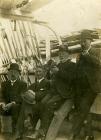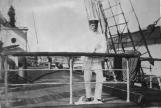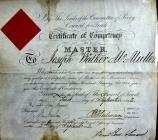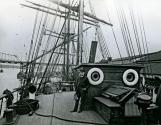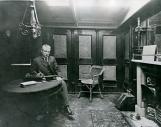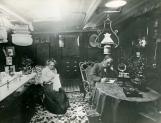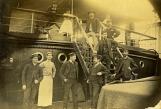1
Yarmouth was known for its vessels and also for its 'sea captains' - the men who took these large sailing vessels to sea and who spread the name of 'Yarmouth' around the globe during the 19th century. To attain the rank of 'Captain' and to be employed to successfully sail a large square-rigged ship was to reach the pinnacle of a career at sea. Many Yarmouth men did this.3
Generally they started off at the lowest level possible: as a cabin boy or an 'ordinary seaman'. Often times, however, they first went to sea under the watchful eye of a father, an uncle or a brother who was themselves a captain. After a certain amount of time at sea during which they learned how to 'hand, reef and steer' - or, in other words, how to be a seaman as well as understanding light and flag signals, cargo handling, boat work, and how to lead men, they would be qualified to write their 'Second Mate's papers'. This was officially known as the 'Ordinary Certificate'. A further time at sea in the job of Second Mate was then required. During this period he would be in charge of a 'watch' (that is, being responsible for the ship for a four hour period, while the Mate was off duty). Then, with perhaps another stint ashore, he could write the examination for Mate. Sample questions (and answers) on this exam might be:Q. You are in the Indian Ocean during the cyclone season, and there are indications that a cyclone is approaching; what action would you take, and what preparations would you make?
Ans. I should heave to on the port tack as it would be safest to assume that I was in the dangerous or left-hand semicircle. I should shorten sail to lower topsails, seeing that every sail was well furled, with the clews rolled right inside the sails and extra gaskets put on wherever necessary. Send down the royal yards if time and weather permits. Secure all the gear about the deck, having the braces clear in a place where they will not be washed away. Examine the hatches carefully, and see that they are well battened down and securely wedged at every cleat. Have the topsails ready for clewing up, oil bags prepared and filled with oil and with lines ready for putting them over. I would also see that I had a good mizzen staysail or storm spanker bent with a reef put in it, and have it set.
Q. Why is it important to have entries of bad weather in the log book?
Ans. So that in case the cargo gets damaged through stress of weather, the log book may be produced in evidence thereof.
5
On successful receipt of their Mate's 'ticket' they would spend an additional time at sea as a Mate. Time at sea in this capacity would mean standing a watch as well as being responsible for all aspects of maintenance of the vessel, its sails, rigging and all other gear. As well the mate would be responsible for tallying the cargo as well as its stowage in the holds.In addition to this time at sea in the capacity of Mate, a period in the classroom would be required before the person could write his examination for Master.
7
As a Master Mariner (the official title for 'Captain') a person would have to know not only seamanship, ship handling, navigation, weather signals, communications and the 'Rules of the Road' but also the official paperwork regarding the ship, cargo and crew. He would also have to understand legal and business dealing with officials, agents and businessmen in a variety of countries. He had to be knowledgeable, competent and completely capable.Story # 12 'The Voyage of Many Rudders' indicates just how these attributes were relevant in saving a ship and its cargo.
